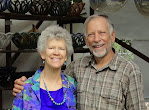Agricultural rhythms on Taquile Island
The citizens of Taquile Island practice a 6 year crop rotation cycle: The first year are potatoes, the second, oca, a sweet delicious tuber in the oxalis family, and the third fava beans and sometimes corn and quinoa. The next three years are fallow, with sheep grazing which fertilizes the soil. When a field is ready to return from fallow to crops, the people dig up the grass near the end of the rainy season to recover over the winter.
 |
| Oca in the sun |
Before cooking, oca is left in the sun for a day, which makes it sweeter!
 |
| Oca in flower |
When people ask, "What do you DO for two months on Taquile?" we tell them we do what they do. In this case, prepare a field for the next planting season,
voltear tierra, or turn the earth/the soil. Withe the strong tradition of reciprocity, or--in Quechua--
ayni, within the Taquile culture, several men joined us to dig with the traditional foot hoe. The women worked to remove rocks from the field. This particular field was deep, rich sand-humus soil, very few rocks. I want to mix it up with my Colorado clay soil.
 |
| many hands make light work |
Little Lisbet and Brayan have a good time in the dirt clods.
 |
| Children have fun while men dig |













